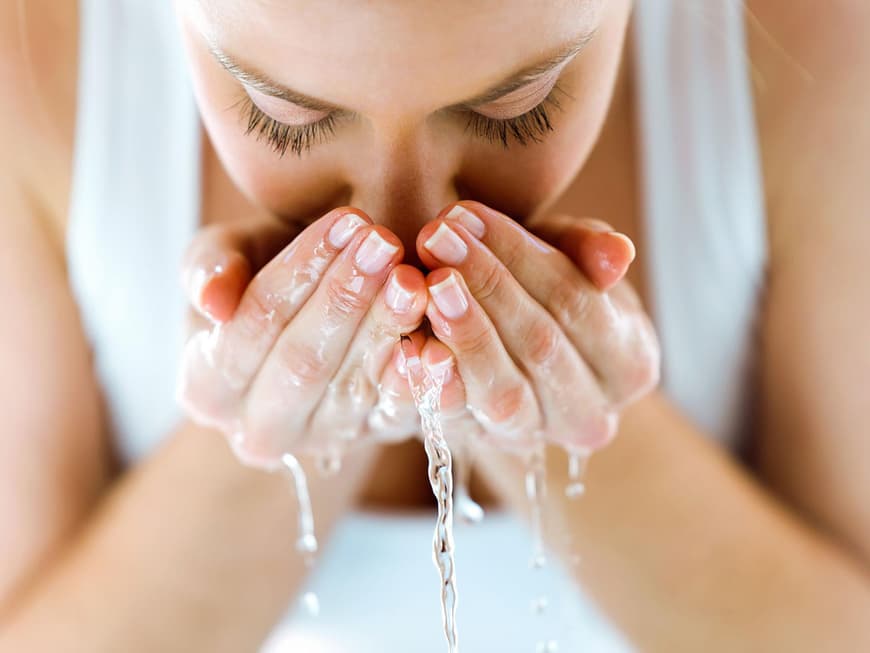
How often is enough?
The decisive factor is not which products you use, but above all your cleaning routine. The motto here is: Twice a day is mandatory. While make-up residue, dirt particles and sweat deposits are removed in the evening, dead skin cells are removed in the morning. The result: the skin is not only cleansed, but also refreshed - as this allows it to absorb the active skincare ingredients that are subsequently applied and then glow beautifully. Don't forget areas such as the neck, hairline, eyebrows or the area behind the ears. Dirt residue here can quickly lead to spots.
On trend: double cleansing
The concept comes from Asia. Two different products are used in succession for particularly intensive cleansing. Daily use is suitable for women with normal to robust skin. All others can use the cleansing ritual once a week without hesitation.
Facial cleansing for oily skin
A shiny face, large pores and pimples indicate this type of skin. Make-up may have disappeared by the evening. This is caused by an overproduction of the sebaceous glands. And: Oily skin also feels like this. The advantage: It is rarely tight and does not dry out as easily.
That fits: Avoid rich cream textures, transparent cleansing gels are ideal. Products with activated charcoal are great as they draw dirt out of the pores, making them less likely to clog. Always clarify the skin with a tonic after cleansing.
Facial cleansing for combination skin
The face of this type looks oily in the T-zone (chin, nose, forehead), but the cheeks and the area around the eyes can feel dry. Many small blackheads tend to form on the nose.
That fits: The right skincare is a balancing act here. Exfoliating once a week (preferably only in the T-zone) clears the pores. Blackheads in the nose area can be treated with deep-cleansing clear-up strips. A mild cleansing lotion with micellar technology (or wipes) can help to even out the skin. Always follow up by cleansing the T-zone with a mild toner.
Facial cleansing for dry skin
The complexion often looks flaky and sallow. Fine lines become more visible, but the pores are rather fine. Dry skin often feels unpleasantly rough and thirsty. It is therefore prone to irritation. You often have the feeling that you need to reapply a lot of cream, and a feeling of tightness can occur after cleansing.
That fits: The complexion should already be cared for when cleansing the face. Rich products with milk or oil are ideal. Avoid harsh ingredients, colorants, fragrances and alcohol. Gentle alternatives such as glycerine, shea butter, hyaluronic acid, natural oils or vitamin E are well suited. Foaming textures have a tendency to dry out the skin.
The 5 biggest mistakes when cleansing your face
Wrong products
If the skin feels tight after cleansing, the cleanser is too aggressive. It is therefore important to know your skin type.
Frequent exfoliation
Regardless of whether you use a classic scrub or an enzyme or acid product - once or twice a week is absolutely enough, otherwise there is a risk of drying out.
Water that is too hot
It all depends on the temperature. Heat leads to redness and irritation, especially for sensitive skin. Around 36 degrees is ideal.
Only remove make-up
Simply removing make-up with a make-up remover is not enough.
Rubbing vigorously
Only dab the skin gently with a soft cloth. Rough scrubbing can encourage wrinkles.
Extra tip
If you want to optimize facial cleansing and feel like you're in a spa, use a facial brush or konjac sponge.
You might also be interested in this:
The best tips for detoxifying, cleansing and protecting your skin
More beautiful skin: 5 effective tips against oily skin and large pores
From dry to sensitive: the right beauty program for every skin type
Natural - skin care and cleansing without chemicals
5 skincare tips for clear skin during the menopause
